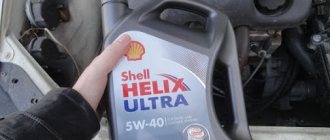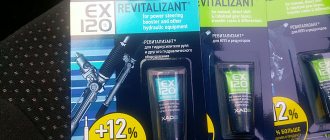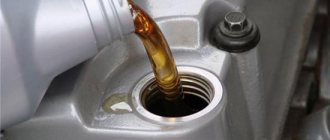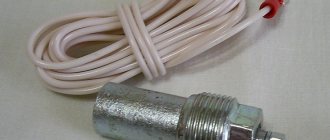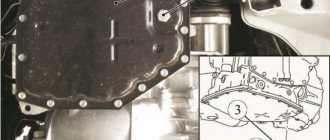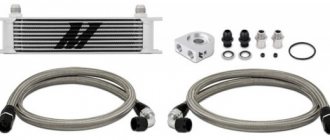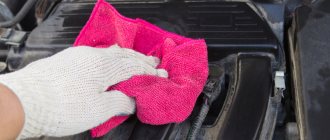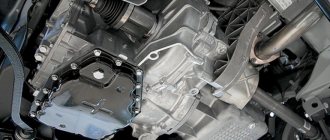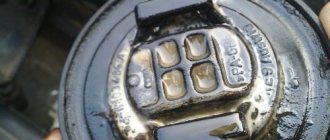Many engine oil additives are designed to protect the engine from excessive lubricant consumption and reduce its smoke. However, only in some cases do supplements prove to be truly effective and help achieve noticeable positive results.
The opposite situations are quite common, when the introduction of additives does not in any way save the situation, but, on the contrary, aggravates it, adding new problems to existing ones.
Let's try to understand the need to use additives in oil and understand the principle of their action, we will name the five most well-known additives and present the results of their tests (data taken from the Internet).
Engine oil additives. What do the manufacturers promise?
Increased engine oil consumption and the appearance of bluish smoke from the exhaust pipe can be caused by various reasons. Among the most common are:
- Unsuitable engine oil for this engine
- Low quality oil
- Wear of elements of the cylinder-piston group
- Position of piston rings
- Problems with valve stem seals
- Leaks through seals and other seals
- Oil entering the exhaust system through the turbocharger
- Malfunctions of the crankcase ventilation system
- Engine oil leaking into the engine cooling system
In the vast majority of cases (except for the use of low-quality oil), eliminating excessive lubricant consumption will require professional repair of the engine or its individual components. This is associated with certain financial costs, often considerable.
Trying to solve the problem without disassembling and repairing the engine, many motorists purchase additives to reduce oil burn and exhaust smoke.
Manufacturers of such additives promise an almost instant effect without changing the basic properties of the oil. In addition to the ability to reduce its consumption, among the advantages of additives are reduced engine noise, increased compression, fuel economy, etc.
In other words, oil additives are positioned as a kind of alternative to overhauling the power unit. However, is this true or is it true? Read on and find out.
Let's sum it up
So, why does high oil consumption occur:
- Wear of sealing elements (seals, caps, gaskets).
- Problems in the aggregate part (rings, cylinders).
If your car begins to consume more oil, you should not ignore this sign. Yes, the engine will work with such malfunctions, but this already indicates its wear and tear or other problems. It is also important to control the oil level to avoid starvation and use a product of the desired viscosity. You can replace oil seals or gaskets yourself, but it is better to entrust work with rings and sleeves to specialists.
How additives work
The effect that manufacturers of oil additives promise must be achieved due to the content of special components in them: a synthetic molybdenum-organic complex, microceramic particles (nanoceramics), molybdenum disulfide, detergents and other substances.
All these components increase the adhesive properties of motor oil and allow it to form a more stable protective film on heavily loaded engine parts.
The principle of action of additives against smoke and oil consumption is approximately the same:
- By settling on the rubbing surfaces inside the power unit, additives reduce their wear
- Additive particles fill microcracks, scratches and other defects in parts, which allows them to be restored to their nominal sizes in a worn engine.
- Additives decarbonize the power unit, that is, they clean it of accumulated deposits and dirt.
As a result, oil consumption is reduced, compression in the cylinders is restored, and the amount of smoke released during combustion of the fuel-air mixture is reduced.
In theory, it sounds tempting, especially considering that the cost of additives is much less than the cost of any manipulations with the engine: disassembly, mechanical cleaning, troubleshooting, and especially repairs. Now let's look at what practice shows.
Bardahl Turbo Protect
Bardahl Turbo Protect
This additive is designed for turbocharged engines, and it is suitable for any of their modifications. Motorists buy this additive for:
- turbocharged diesel and gasoline units;
- for passenger and commercial vehicles;
- for sports cars.
The additive includes a good cleaning package, so the composition cleanses the insides of the engine well from dirt and carbon deposits. Due to the phosphorus and zinc content, this additive ensures the formation of a strong protective film between rubbing parts.
Benefits and harms
Let's start with the positive aspects of using additives. It has been repeatedly proven that oil additives actually help strengthen the oil layer and temporarily (key words) protect the engine from increased wear.
Additives will help in case of a critical drop in the oil level without the possibility of topping it up or stopping the movement (for example, if the oil pan was broken on the highway and you need to get to a nearby car service center).
In some cases, additives can extend the “life” of an old, worn-out engine that cannot be operated normally without repair. However, as mentioned above, this will be a temporary measure.
Thus, we can conclude: all additives to the oil only delay time until problems with the power unit are resolved. At the same time, they allow car owners not to add a liter of oil every 100-200 km, and also provide the opportunity to switch to a cheaper lubricant and thereby save money.
Now let's move on to the disadvantages of additives.
The main disadvantage of additives to reduce oil consumption is their short-term effect, as well as unpredictable consequences for the engine. The latter become obvious only after disassembling the power unit for major repairs.
Auto mechanics note that anti-wear additives coat engine parts with a certain layer that is sometimes impossible to remove.
Some experts claim that after using certain additives, pistons and cylinders cannot be restored (grinding, boring, etc.). These expensive elements require mandatory replacement.
Repairing an engine that regularly uses additives to reduce oil consumption typically costs 20-50% more than the cost of repairing units that did not use these compounds.
Leak formation
Over time, the system loses its novelty, so it begins to leak in some places. This especially often happens due to valve stem seals. They lose their elasticity, which leads to leaks. It is worth immediately noting that such malfunctions must be eliminated through repairs. No additive will solve this problem.
Why are they then necessary? They are used for short-term effects. If you went on vacation or to another city and discovered a leak, it is usually not possible to fix it promptly. But this composition will help you reach the garage or service station. Regular use of such additives can adversely affect engine parts and disrupt its operation.
Feasibility of application
So, we found out that additives to reduce oil consumption create a certain layer on the internal surfaces of the engine that restores the dimensions of the parts and reduces the gap between them.
In addition, additives make engine oil thicker and reduce its flammability. That is, they perform their tasks, but there is no benefit for the engine.
A car engine is a very complex mechanism. During its development, great attention is paid to the size of the gaps, temperature conditions, etc. For this reason, each powertrain manufacturer recommends the use of strictly limited groups of motor oils that meet certain standards and tolerances.
Any additives to the oil inevitably change its composition. Moreover, their components react with additives contained in the oil itself. It is quite logical to draw the following conclusions:
- Additives can, to a greater or lesser extent, solve the problem of increased oil consumption and engine smoke.
- The positive effect is temporary and not always complete, while the consequences for the engine cannot be predicted
Thus, the use of additives is fully justified only if the car owner does not initially plan to repair the engine. Additives will allow you to operate the car for some time. While the additives are in effect, there will be no need to fill in the recommended oil and regularly replenish its level.
Important properties of the stabilizer
Any stabilizing additive, be it Liqui Moly or a product from the Hi-Gear brand, has several undeniable advantages:
- The additive can be used with any type of engine. In this case, it makes no difference what kind of lubricant will be poured into the system - mineral or synthetic.
- The technology for producing an additive that increases the viscosity value meets the requirements for the use of such an agent for addition to all universal oils.
- Operates based on engine operating conditions. This fact is especially important for the constantly changing shear load occurring between the cylinder and the piston.
- Maintains the viscosity grade of the lubricant and provides the oil with the best properties. In addition, it reduces wear and increases sealing of the CPG.
The use of a stabilizer will quickly solve many problems that arise in the oil system.
Test of five oil additives
The tests involved 5 identical engines and 5 different additives. Four of them were poured into the oil necks before the start of operation of the power units, the fifth (Suprotek) was added twice according to the instructions - before the start of the break-in and after a thousand kilometers.
Testing took place for 120 engine hours, which is equivalent to 10,000 km in the selected operating modes. Based on the test results, the engines were disassembled and the condition of the parts and engine oil was analyzed.
Separately, the ability of additives to “treat” power units was tested: this stage of testing was carried out for 60 operating hours on a stand. To bring the engines into the desired condition, identical marks were applied to the working surfaces of the new liners and piston rings, simulating significant wear. Each additive was tested. Experts assessed how much she was able to restore the deteriorated parameters.
XADO 1 Stage Atomic Metal Conditioner
The Ukrainian manufacturer calls this product an atomic metal conditioner with revitalizant.
The annotation states the additive’s ability to restore the surfaces of parts and compensate for their wear, level and increase compression in the cylinders, reduce fuel consumption, increase power, throttle response and engine life.
The manufacturer's promises were confirmed, but the results obtained were average on all counts.
Engine power increased by 2.7%. The indicator is not fantastic, but comparable to the gains that simple engine tuning gives. Friction losses decreased by 8-9%, compression increased by an average of 0.2-0.3 bar. The promised significant reduction in oil consumption was not found.
Conclusion: it is not easy to understand the description of the XADO 1 Stage AMC additive, it is quite expensive, and gives an average effect only after some time.
Suprotec Active Plus
Russian-made additive for gasoline engines.
The manufacturer promises noise reduction, easier cold starts, increased power unit life and protection of parts from wear.
Engine power with the Suprotec Active Plus additive increased by 4%, efficiency by 5.6%, fuel consumption decreased by 7.4%.
Suprotec Active Plus is the only composition of all that was able to increase the hardness of the surfaces of the main and connecting rod journals by 4-6% (additional studies were carried out before and after the main tests by tapping the journals of all crankshafts with a dynamic hardness tester).
Conclusion: in oil that was used on a relatively “clean” engine, the Suprotec Active Plus additive showed the best result. However, when treating a “sick” unit at the second stage of testing, the product did not prove to be so effective. The main disadvantage of the additive is the need for two-stage filling. It's not very convenient and expensive.
Liqui Moly Ceratec
Additive for motor and transmission oils from a well-known German manufacturer.
In the product description, he claims the additive's ability to reduce friction and wear over 50,000 km. The composition of the additive mentions the presence of special microceramic particles with “additional chemically active” elements that fill micro-irregularities.
The test results of Liqui Moly Ceratec in all respects are not the most outstanding, but visible and stable. It increases engine power by 3.7%, efficiency by 3.4%, and reduces fuel consumption by 4.3%.
Conclusion: tests have shown that the Liqui Moly additive does not reduce the coefficient of friction as significantly as other drugs. However, it is easy to use, and the additive is relatively inexpensive (cheaper than the Ukrainian one).
SMT Oil Treatment
The cheapest additive of all tested. Made in the USA.
The list of additive functions states a reduction in oil consumption and exhaust gas opacity, an increase in the mobility of piston rings, an increase in engine power and a decrease in fuel consumption, and an increase in compression.
During testing of the additive, a general trend towards improving the parameters of the power unit can be seen, but they are minimal. It increases engine power by 1.3%, increases mechanical efficiency by 2.5%, and reduces fuel consumption by 2.5%.
Conclusion: the additive attracts with its affordable price, but is rarely found on sale. The resulting effects are slightly higher than the measurement error, so it will be difficult to feel them during the operation of the car.
What additive should I fill in to prevent the engine from smoking?
What should I put into the engine before selling it so that it doesn’t smoke?
Good day. Now we have another article about the secrets of resellers. It happens that you have to sell a car with a dead engine that smokes; here, pouring a special anti-smoke additive will help you. In the text of the article there is a video example of the use of this additive and its consequences.
The moral side of using the additive...
Put yourself in the buyer's area, you purchased such a car and when changing the oil, as it is also called, even after 2-3 days it began to smoke. Will it be pleasant for you?
To my shame, I only used this additive once! That’s when my ears “burned”... It’s better to lose 10-20 rubles, but honestly tell the buyer about the dilemma, and either fill it with thick expensive oil, alas, no additives.
Technical side...
There are 2 types of additives (non-working and working).
Ineffective additives.
We consider non-working additives that are sealed with ceramics, bulges in the cylinder-piston group, and as a result of this factor, compression increases and oil consumption decreases...
Immediately, our client remains well…. If this were so, motor mechanics would become janitors, or painters...
Agree that if these additives worked, what remains to be done is that our client would fill them in and not even pay for expensive engine repairs.
Working additives.
It is not possible to repair the engine using additives, but you can reduce the smoke level with the so-called. oil thickeners.
https://youtube.com/watch?v=lGfLMvDAmxY
Engine additives. Real experiment with RVS-master
Video showing how I repaired the engine using RVS-master. I took the additive for the car here: .
How it works?
A honey-like liquid is poured into the engine. It increases the viscosity of the oil, i.e. it was 10W-40, now it’s 20W-60, it seems like a good period, and although the smokiness decreases, the oil pressure increases and sometimes the noise level decreases, but a problem appears - accelerated wear of the engine. Often the wear and tear becomes hellish!
Smokiness is reduced by the fact that thicker oil enters the combustion chambers in significantly smaller quantities, however, thick oil does not lubricate the cylinder walls well, and wear on the cylinder-piston group will be very rapid.
The worst thing is that the additive will not guarantee that the oil will not thicken significantly.
Experience using the additive:
We had a cherry amulet for sale. It was painted, but it was impractical to make the engine; it smoked like this:
They didn’t sell it during the week, but we drove the car, and the result was this:
What additive should I fill in to prevent the engine from smoking?
The result was that the engine had to be rebuilt! The additive works, but only if you fill it in during the day, drive the car to the car market by lunchtime, and sell it by the evening. Alas, I strongly advise you not to do this, because if you earn 5-10 thousand rubles from this business. however, whether you will ultimately lose your reputation, whether it is worth such money is up to you to decide.
What should you put into the engine to relatively honestly sell a car with a smoking engine?
It's simple. As we learned above, an additive that reduces smokiness thickens the oil. Accordingly, pouring thick oil will always get a similar effect.
Fill with 5w-50 or even 10W-60 oil! Yes, this oil is quite expensive (at the time of writing about 500 rubles per liter), but this oil will not damage the engine as much as the additive.
By the way, all oils with such a viscosity are synthetic, with a low sulfur content, so these oils burn with a minimum amount of smoke!
That's all for me today. I think the article answered in detail the question of what to put in the engine so that it does not smoke before selling it?
If you have any questions or want to share your experience, please use the comments.
“Peter - AT” INN 780703320484 OGRNIP 313784720500453

